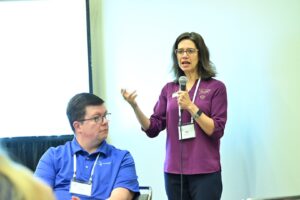By Jessica Griggs for Mennonite Church USA
KANSAS CITY, Mo. (Mennonite Church USA) — MennoMedia led two seminars about the agency’s Anabaptist at 500 project during the first full day of MennoCon23, Mennonite Church USA’s leading faith formation event.
Anabaptism at 500
 The first seminar, “Anabaptism at 500,” was presented by Amy Gingerich, MennoMedia’s executive director and publisher, and Mitch Stutzman, MennoMedia’s director of development and partner engagement. This seminar gave an overview of the Anabaptism at 500 project, MennoMedia’s celebration the 500-year anniversary of Anabaptism, which will occur in 2025.
The first seminar, “Anabaptism at 500,” was presented by Amy Gingerich, MennoMedia’s executive director and publisher, and Mitch Stutzman, MennoMedia’s director of development and partner engagement. This seminar gave an overview of the Anabaptism at 500 project, MennoMedia’s celebration the 500-year anniversary of Anabaptism, which will occur in 2025.
Stutzman gave a brief history of the beginning of Anabaptism to provide insight into the project’s inspiration. He explained that the early Anabaptists came to believe that a communal reading of the Bible by all believers outweighed the dogma of the clerical interpretations. This became the inspiration for the Anabaptist Community Bible.
“It was young people who started the Anabaptist movement in 1525, and they started it by reading the Bible,” Gingrich said. “So as we started dreaming, it became clear to us that we didn’t want to create resources to celebrate what started in 1525 without paying attention to the Bible and how it’s relevant in our lives today, and how it is relevant to younger people, not just older people.”
The Anabaptist Community Bible is a crowd-sourced study Bible that MennoMedia is currently compiling. Earlier this year, 593 small groups from 53 Anabaptist traditions across 20 countries signed up to receive three passages of Scripture to study, using a set of prompts provided by MennoMedia. These groups sent their study notes back to MennoMedia, and now MennoMedia is working to compile those notes, along with scholarly and historical Anabaptist’s scriptural observations, into a single study Bible, which is slated to be released in 2025.
“We are not the only Anabaptists in the world; not just the world, we are not the only Anabaptists in this country,” Stutzman said. “There are a lot of different streams within the broader tradition, and we hope this project can capture some of what’s happening across all these streams.”
The Anabaptist Community Bible will utilize the Common English Bible (CEB) translation. Gingerich explained that this choice allows for the text of the Bible to be accessible to a larger audience, while still displaying the academic rigor of the NRSV and the readability of the NIV.
In addition to the physical Bible, MennoMedia will introduce an app with the study Bible and expanded notes.
The Anabaptist Community Bible
The second seminar, “The Anabaptist Community Bible,” was led by Gingerich, Stutzman, and two members of the Anabaptism Community Bible advisory group, Sarah Augustine and Gerald Mast. This seminar was focused more directly on the details of the Anabaptist Community Bible, with more in-depth discussions about the thoughts and processes that are being implemented to complete the project.
Mast discussed his involvement in the Early Anabaptist Witness Notes, which will make up part of the study notes in the margins of the Bible. He said that he has been combing through historical Anabaptist documents, such as the Martyr’s Mirror, to incorporate the thoughts of early Anabaptist thinkers, with a focus on including the voices of women. He will also provide a supplemental essay on the Anabaptist use of the Apocrypha.
Augustine, who is also the executive director of the Coalition to Dismantle the Doctrine of Discovery, talked about her involvement in creating an additional list of study group questions that incorporated a decolonial lens, so that participants would consider more marginalized people and inanimate objects, such as the land. She will also provide an introduction to the book of Ruth.
“It is exciting to be able to read our contributions to the cannon, yours and mine, in dialogue with the people that came before us,” Augustine said. “We are a part of the cloud of witnesses of all believers and we get to read and speak to each other in the cannon that we are creating of our experience on this world.”
In addition to the study notes from study groups, scholars and early Anabaptists, some features of the Anabaptist Community Bible include: maps, artist renderings of significant passages, supplemental essays and introductions to each book.
Presenters offered a time for audience members who participated in the Anabaptist Community Bible study groups to share about their own experiences. Participants from across the U.S. shared about how the prompts provided by MennoMedia and additional prompts provided by the Coalition to Dismantle the Doctrine of Discovery, led their groups to have deep and fulfilling conversations about the passages that their groups were assigned. Some identified specific instances of growth related to hearing the viewpoints of others in their groups. Others shared that their groups experienced a sense of relief, as they were able to share ongoing questions they have about the text.
Mennonite Church USA is the largest Mennonite denomination in the United States with 16 conferences, approximately 517 congregations and almost 52,000 members. An Anabaptist Christian denomination, MC USA is part of Mennonite World Conference, a global faith family that includes churches in 59 countries. It has offices in Elkhart, Indiana, and Newton, Kansas. mennoniteUSA.org

